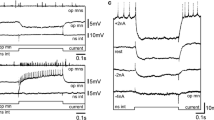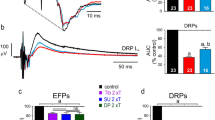Abstract
Electrical stimulation of mechanosensory afferents innervating hairs on the surface of the exopodite in crayfish Procambarus clarkii (Girard) elicited reciprocal activation of the antagonistic set of uropod motor neurones. The closer motor neurones were excited while the opener motor neurones were inhibited. This reciprocal pattern of activity in the uropod motor neurones was also produced by bath application of acetylcholine (ACh) and the cholinergic agonist, carbamylcholine (carbachol). The closing pattern of activity in the uropod motor neurones produced by sensory stimulation was completely eliminated by bath application of the ACh blocker, d-tubocurarine, though the spontaneous activity of the motor neurones was not affected significantly. Bath application of the acetylcholinesterase inhibitor, neostigmine, increased the amplitude and extended the time course of excitatory postsynaptic potentials (EPSPs) of ascending interneurones elicited by sensory stimulation. These results strongly suggest that synaptic transmission from mechanosensory afferents innervating hairs on the surface of the tailfan is cholinergic.
Bath application of the cholinergic antagonists, dtubocurarine (vertebrate nicotinic antagonist) and atropine (muscarinic antagonist) reversibly reduced the amplitude of EPSPs in many identified ascending and spiking local interneurones during sensory stimulation. Bath application of the cholinergic agonists, nicotine (nicotinic agonist) and oxotremorine (muscarinic agonist) also reduced EPSP amplitude. Nicotine caused a rapid depolarization of membrane potential with, in some cases, spikes in the interneurones. In the presence of nicotine, interneurones showed almost no response to the sensory stimulation, probably owing to desensitization of postsynaptic receptors. On the other hand, no remarkable changes in membrane potential of interneurones were observed after oxotremorine application. These results suggest that ACh released from the mechanosensory afferents depolarizes interneurones by acting on receptors similar to vertebrate nicotinic receptors.
Similar content being viewed by others
Abbreviations
- ACh :
-
cetylcholine
- mns :
-
motor neurones
- asc int :
-
ascending interneurone
References
Atwood HL (1982) Synapses and neurotransmitters. In: Bliss DE (ed) The biology of Crustacean, vol 3. Academic Press, New York, pp 105–150
Barker DL, Herbert E, Hildebrand JG, Kravitz EA (1972) Acetylcholine and lobster sensory neurones. J Physiol (Lond) 226: 205–229
Barker DL, Murray TF, Sibenaller JF, Mpitsos GJ (1986) Characterization of muscarinic cholinergic receptors in crab nervous system. J Neurochem 46: 583–588
Breer H, Sattelle DB (1987) Molecular properties and functions of insect acetylcholine receptors. J Insect Physiol 33: 771–790
Carr CE, Fourtner CR (1980) Pharmacological analysis of a monosynaptic reflex in the cockroach, Periplaneta americana. J Exp Biol 86: 259–273
Cattaert D, Araque A, Buno W, Clarac F (1994) Nicotinic and muscarinic activation of motoneurons in the crayfish locomotor network. J Neurophysiol 72: 1622–1633
Florey E (1967) Neurotransmitters and modulators in the animal kingdom. Fed Proc 26: 1164–1178
Florey E (1973) Acetylcholine as sensory transmitter in Crustacea. J Comp Physiol 83: 1–16
Florey E, Biederman MA (1960) Studies on the distribution of Factor I and acetylcholine in crustacean peripheral nerve. J Gen Physiol 43: 509–522
Hildebrand JG (1982) Chemical signalling in the insect nervous system. In: Neuropharmacology of insects. Ciba Foundation 1982, pp 5–11
Hildebrand JG, Townsel JG, Kravitz EA (1974) Distribution of acetylcholine, choline, choline acetyltransferase and acetylcholinesterase in regions and single identified axons of the lobster nervous system. J Neurochem 23: 951–963
Hue B, Lapied B, Malecot CO (1989) Do presynaptic muscarinic receptors regulate acetylcholine release in the central nervous system of the cockroach Periplaneta americana? J Exp Biol 142: 447–451
Katz PS, Harris-Warrick RM (1989) Serotonergic/cholinergic muscle receptor cells in the crab stomatogastric nervous system II. Rapid nicotinic and prolonged modulatory effects on neurones in the stomatogastric ganglion. J Neurophysiol 62: 571–581
Katz B, Thesleff S (1957) A study of the ‘desensitization’ produced by acetylcholine at the motor end-plate. J Physiol (Lond) 138: 63–80
Katz PS, Eigg MH, Harris-Warrick RM (1989) Serotonergic/ cholinergic muscle receptor cells in the crab stomatogastric nervous system I. Identification and characterization of the gastropyloric receptor cells. J Neurophysiol 62: 558–570
Marder E, Paupardin-Tritsch D (1978) The pharmacological properties of some crustacean neuronal acetylcholine, gammaaminobutyric acid, and L-glutamate responses. J Physiol (Lond) 280: 213–236
Marder E, Paupardin-Tritsch D (1980) The pharmacological profile of the acetylcholine response of a crustacean muscle. J Exp Biol 88: 147–159
Maynard EA (1971) Microscopic localization of cholinesterase in the nervous system of the lobsters, Panulirus argus and Homarus americanus. Tissue & Cell 3: 215–250
McCaman MW (1984) Neurochemistry of invertebrates. In: Lajtha A (ed) Handbook of Neurochemistry, vol 7. Plenum, New York, pp 613–700
Miller MW, Vu ET, Krasne FB (1992) Cholinergic transmission at first synapse of the circuit mediating the crayfish lateral giant escape reaction. J Neurophysiol 68: 2174–2184
Nagayama T, Hisada M (1987) Opposing parallel connections through crayfish local nonspiking interneurons. J Comp Neurol 257: 347–358
Nagayama T, Sato M (1993) The organization of exteroceptive information from the uropod to ascending interneurones of the crayfish. J Comp Physiol A 172: 281–294
Nagayama T, Takahata M, Hisada M (1983) Local spikeless interaction of motoneuron dendrites in the crayfish Procambarus clarkii Girard. J Comp Physiol 152: 335–345
Nagayama T, Takahata M, Hisada M (1984) Functional characteristics of local non-spiking interneurons as the pre-motor elements in crayfish. J Comp Physiol A 154: 499–510
Nagayama T, Takahata M, Hisada M (1986) Behavioral transition of crayfish avoidance reaction in response to uropod stimulation. Exp Biol 46: 75–82
Nagayama T, Isogai Y, Sato M, Hisada M (1993a) Intersegmental ascending interneurones controlling uropod movements of the crayfish Procambarus clarkii. J Comp Neurol 332: 155–174
Nagayama T, Isogai Y, Namba H (1993b) Physiology and morphology of spiking local interneurons in the terminal abdominal ganglion of the crayfish. J Comp Neurol 337: 584–599
Nagayama T, Namba H, Aonuma H (1994) Morphological and physiological bases of crayfish local circuit neurones. Histol Histopathol 9: 791–805
Namba H, Nagayama T, Hisada M (1994) Descending control of nonspiking local interneurons in the terminal abdominal ganglion of the crayfish. J Neurophysiol 72: 235–247
Parker D, Newland PL (1995) Cholinergic synaptic transmission between proprioceptive afferents and a hind leg motor neurone in the locust. J Neurophysiol 73: 586–594
Pfeiffer C, Glantz RM (1989) Cholinergic synapses and the organization of contrast detection in the crayfish optic lobe. J Neurosci 9: 1872–1882
Sattelle DB (1980) Acetylcholine receptors of insects. Adv Insect Physiol 15: 215–315
Stewart W (1978) Functional connections between cells as revealed by dye-coupling with the highly fluorescent naphthalimide tracer. Cell 14: 741–759
Thesleff S (1955) The mode of neuromuscular block caused by acetylcholine, nicotine, decamethonium and succinylcholine. Acta Physiol Scand 34: 218–231
Trimmer BA, Weeks JC (1989) Effects of nicotinic and muscarinic agents on an indentified motoneurone and its direct afferent inputs in larval Manduca sexta. J Exp Biol 144: 303–337
Trimmer BA, Weeks JC (1993) Muscarinic acetylcholine receptors modulate the excitability of an identified insect motoneuron. J Neurophysiol 69: 1821–1836
van Harreveld A (1936) A physiological solution for freshwater crustaceans. Proc Soc Exp Biol Med 34: 428–432
Wang-Bennett LT, Sovan ML, Glantz RM (1988) Immunocytochemical studies of the distribution of acetylcholine in the crayfish brain. J Comp Neurol 273: 330–343
Wang-Bennett LT, Pfeiffer C, Arnold J, Glantz RM (1989) Acetylcholine in the crayfish optic lobe: concentration profile and cellular localization. J Neurosci 9: 1864–1871
Author information
Authors and Affiliations
Rights and permissions
About this article
Cite this article
Ushizawa, T., Nagayama, T. & Takahata, M. Cholinergic transmission at mechanosensory afferents in the crayfish terminal abdominal ganglion. J Comp Physiol A 179, 1–13 (1996). https://doi.org/10.1007/BF00193430
Accepted:
Issue Date:
DOI: https://doi.org/10.1007/BF00193430




